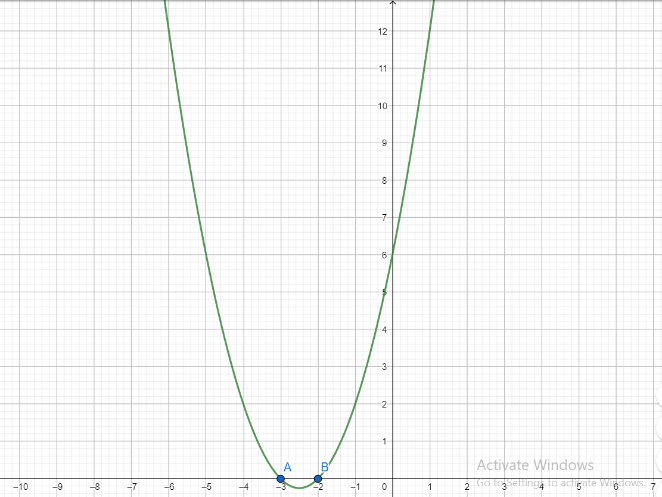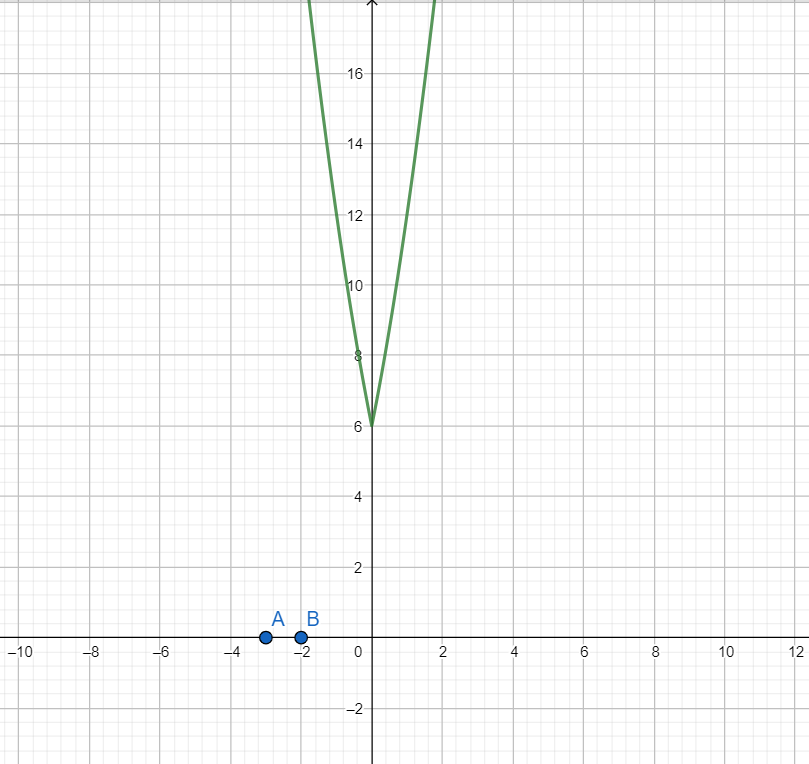
Answer
496.8k+ views
Hint: Solve for cases when x>0 and $x\le 0$ individually and remove extraneous roots(means which does not satisfy two cases). Use property that |x| = x when x>0 and |x| = -x when $x\le 0$. Find the sum of all the real roots found. Alternatively, you can plot the given function and find the points at which the graph of the given function intersects the x-axis.
“Complete step-by-step answer:”
We will solve the above question for two cases.
Case I: x>0
We have |x| = x
$\Rightarrow {{x}^{2}}+5x+6=0$
Using the quadratic formula which states that for quadratic equation $a{{x}^{2}}+bx+c=0$ the roots are $x=\dfrac{-b\pm \sqrt{{{b}^{2}}-4ac}}{2a}$
Here a = 1, b = 5 and c = 6
Using the quadratic formula, we get
$\begin{align}
& x=\dfrac{-5\pm \sqrt{{{5}^{2}}-4\left( 1 \right)\left( 6 \right)}}{2\left( 1 \right)} \\
& \Rightarrow x=\dfrac{-5\pm \sqrt{25-24}}{2} \\
& \Rightarrow x=\dfrac{-5\pm \sqrt{1}}{2}=\dfrac{-5\pm 1}{2} \\
& \Rightarrow x=\dfrac{-5+1}{2}\text{ or }x=\dfrac{-5-1}{2} \\
& \Rightarrow x=-2\text{ or }x=-3 \\
\end{align}$
Since x>0 both x = -2 and x = -3 are extraneous roots.
Case II: $x\le 0$
We have |x| = -x
$\Rightarrow {{x}^{2}}-5x+6=0$
Here a = 1, b = -5 and c = 6
Using the quadratic formula, we get
$\begin{align}
& x=\dfrac{-\left( -5 \right)\pm \sqrt{{{\left( -5 \right)}^{2}}-4\left( 1 \right)\left( 6 \right)}}{2\left( 1 \right)} \\
& \Rightarrow x=\dfrac{5\pm \sqrt{25-24}}{2} \\
& \Rightarrow x=\dfrac{5\pm \sqrt{1}}{2}=\dfrac{5\pm 1}{2} \\
& \Rightarrow x=\dfrac{5+1}{2}\text{ or }x=\dfrac{5-1}{2} \\
& \Rightarrow x=3\text{ or }x=2 \\
\end{align}$
Since $x\le 0$, both x = 3 and x =2 are extraneous roots.
Hence the given equation has no real roots
Hence option D is correct.
Note: Alternative solution:
If we know the graph of f(x) then the graph of f(|x|) is the same as the graph f(x) for x>0 and for $x\le 0$ the graph is the mirror image taken in the y-axis.
Let $f(x)={{x}^{2}}+5x+6$
Then $f\left( \left| x \right| \right)={{x}^{2}}+5\left| x \right|+6$
First, we draw the graph of f(x)

Then using the above-mentioned fact, we draw the graph of f(|x|)

As is evident from the graph, the function f(|x|) does not have any root because it does not intersect the x-axis.
Hence the given equation ${{x}^{2}}+5\left| x \right|+6=0$ has no real roots.
“Complete step-by-step answer:”
We will solve the above question for two cases.
Case I: x>0
We have |x| = x
$\Rightarrow {{x}^{2}}+5x+6=0$
Using the quadratic formula which states that for quadratic equation $a{{x}^{2}}+bx+c=0$ the roots are $x=\dfrac{-b\pm \sqrt{{{b}^{2}}-4ac}}{2a}$
Here a = 1, b = 5 and c = 6
Using the quadratic formula, we get
$\begin{align}
& x=\dfrac{-5\pm \sqrt{{{5}^{2}}-4\left( 1 \right)\left( 6 \right)}}{2\left( 1 \right)} \\
& \Rightarrow x=\dfrac{-5\pm \sqrt{25-24}}{2} \\
& \Rightarrow x=\dfrac{-5\pm \sqrt{1}}{2}=\dfrac{-5\pm 1}{2} \\
& \Rightarrow x=\dfrac{-5+1}{2}\text{ or }x=\dfrac{-5-1}{2} \\
& \Rightarrow x=-2\text{ or }x=-3 \\
\end{align}$
Since x>0 both x = -2 and x = -3 are extraneous roots.
Case II: $x\le 0$
We have |x| = -x
$\Rightarrow {{x}^{2}}-5x+6=0$
Here a = 1, b = -5 and c = 6
Using the quadratic formula, we get
$\begin{align}
& x=\dfrac{-\left( -5 \right)\pm \sqrt{{{\left( -5 \right)}^{2}}-4\left( 1 \right)\left( 6 \right)}}{2\left( 1 \right)} \\
& \Rightarrow x=\dfrac{5\pm \sqrt{25-24}}{2} \\
& \Rightarrow x=\dfrac{5\pm \sqrt{1}}{2}=\dfrac{5\pm 1}{2} \\
& \Rightarrow x=\dfrac{5+1}{2}\text{ or }x=\dfrac{5-1}{2} \\
& \Rightarrow x=3\text{ or }x=2 \\
\end{align}$
Since $x\le 0$, both x = 3 and x =2 are extraneous roots.
Hence the given equation has no real roots
Hence option D is correct.
Note: Alternative solution:
If we know the graph of f(x) then the graph of f(|x|) is the same as the graph f(x) for x>0 and for $x\le 0$ the graph is the mirror image taken in the y-axis.
Let $f(x)={{x}^{2}}+5x+6$
Then $f\left( \left| x \right| \right)={{x}^{2}}+5\left| x \right|+6$
First, we draw the graph of f(x)

Then using the above-mentioned fact, we draw the graph of f(|x|)

As is evident from the graph, the function f(|x|) does not have any root because it does not intersect the x-axis.
Hence the given equation ${{x}^{2}}+5\left| x \right|+6=0$ has no real roots.
Recently Updated Pages
Fill in the blanks with suitable prepositions Break class 10 english CBSE

Fill in the blanks with suitable articles Tribune is class 10 english CBSE

Rearrange the following words and phrases to form a class 10 english CBSE

Select the opposite of the given word Permit aGive class 10 english CBSE

Fill in the blank with the most appropriate option class 10 english CBSE

Some places have oneline notices Which option is a class 10 english CBSE

Trending doubts
Fill the blanks with the suitable prepositions 1 The class 9 english CBSE

How do you graph the function fx 4x class 9 maths CBSE

Which are the Top 10 Largest Countries of the World?

What is the definite integral of zero a constant b class 12 maths CBSE

The Equation xxx + 2 is Satisfied when x is Equal to Class 10 Maths

Differentiate between homogeneous and heterogeneous class 12 chemistry CBSE

Define the term system surroundings open system closed class 11 chemistry CBSE

Full Form of IASDMIPSIFSIRSPOLICE class 7 social science CBSE

Change the following sentences into negative and interrogative class 10 english CBSE




